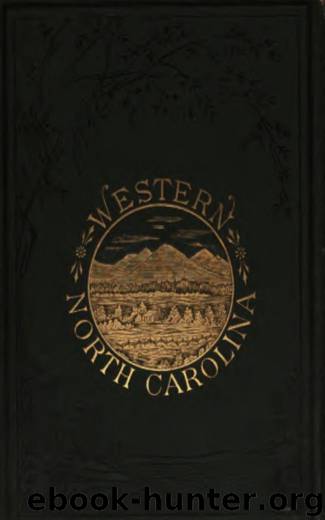Western North Carolina - The Heart of the Alleghanies by Ben S. Grosscup

Author:Ben S. Grosscup [Grosscup, Ben S.]
Language: eng
Format: epub
Published: 2016-07-30T00:00:00+00:00
Maple, linn, sycamore, cucumber, mulberry, sassafras, dogwood, sourwood, gopher, and buckeye is a partial list of the remaining deciduous trees.
Above all, enveloping the summits of the highest ranges in impenetrable shade, silent and somber, stand forests of balsam fir. The general character of these dense, dark thickets is described elsewhere. The wood itself remains briefly to be spoken of. The fir of the North Carolina Alleghanies differs from the species in the far north, both in the size of the tree and in the smoothness and density of the wood. It may be looked for in the three localities, each, however, embracing a large area of territory—the culmination of the Balsams at the corners of Haywood, Transylvania and Jackson; on the great Smoky chain, and within the ellipse of the Blacks. The “female tree,” which is cone shaped and has limbs to the grounds, is worthless except for the resin of the blister drawn out by puncturing the bark at a certain season of the year, and used as the base of medicinal preparation. The “male tree” grows to a diameter of two feet, and has a straight, clear trunk to the length of thirty to sixty feet. The wood is straight, fine grained, firm, and unelastic. It is highly charged with acetic sap, which makes the green lumber very heavy. When dried it becomes light—lighter than white pine. In color it is as white as the paper on which this is printed, and the density and firmness of the grain makes it susceptible of high polish. The same structure renders it impervious to water. The writer was shown a churn made of balsam staves which had been in use for thirty years. The wood under the surface was not even stained. This wood has received no attention from wood manufacturers, but it may some time be valuable for ship-building, buckets, and for house-finishing. For the latter purpose it will rival in color and surface the world-famed satin wood of California.
The arborescent kalmia and rhododendron, which grow along almost every mountain stream, have a practical use. The ivy and laurel, as they are locally called, attain, in some of the fertile coves, a diameter of three inches, and the roots are even larger. Their graceful crooks and turns and bulbous, burly roots, make them exceptionally fine timber for all kinds of rustic devices—fences, flower urns, chairs, etc. The wood can be worked only when green; dried, it becomes as hard as bone. Its density, hardness, and mottled grain, make it a valuable wood for pipe bowls and knobs, also for light tool handles and shuttles. No use is made of these shrubs at present, except for rustic furniture.
At present, Hickory manufactures more lumber than any other town in the state west of the Catawba. Highlands, on the Blue Ridge, probably deserves the second place, though the industry is only in its infancy. We have no hesitancy in saying that the forests in the western section are intrinsically more valuable than in the middle belt of North Carolina, or in any part of South Carolina.
Download
This site does not store any files on its server. We only index and link to content provided by other sites. Please contact the content providers to delete copyright contents if any and email us, we'll remove relevant links or contents immediately.
| Africa | Americas |
| Arctic & Antarctica | Asia |
| Australia & Oceania | Europe |
| Middle East | Russia |
| United States | World |
| Ancient Civilizations | Military |
| Historical Study & Educational Resources |
Cat's cradle by Kurt Vonnegut(15184)
Pimp by Iceberg Slim(14393)
4 3 2 1: A Novel by Paul Auster(12283)
Underground: A Human History of the Worlds Beneath Our Feet by Will Hunt(12024)
The Radium Girls by Kate Moore(11921)
Wiseguy by Nicholas Pileggi(5671)
Perfect Rhythm by Jae(5324)
American History Stories, Volume III (Yesterday's Classics) by Pratt Mara L(5256)
The Fire Next Time by James Baldwin(5249)
Paper Towns by Green John(5089)
Pale Blue Dot by Carl Sagan(4912)
A Higher Loyalty: Truth, Lies, and Leadership by James Comey(4843)
The Mayflower and the Pilgrims' New World by Nathaniel Philbrick(4423)
The Doomsday Machine by Daniel Ellsberg(4416)
Killers of the Flower Moon: The Osage Murders and the Birth of the FBI by David Grann(4385)
The Sympathizer by Viet Thanh Nguyen(4305)
Too Much and Not the Mood by Durga Chew-Bose(4272)
The Borden Murders by Sarah Miller(4247)
Sticky Fingers by Joe Hagan(4101)
